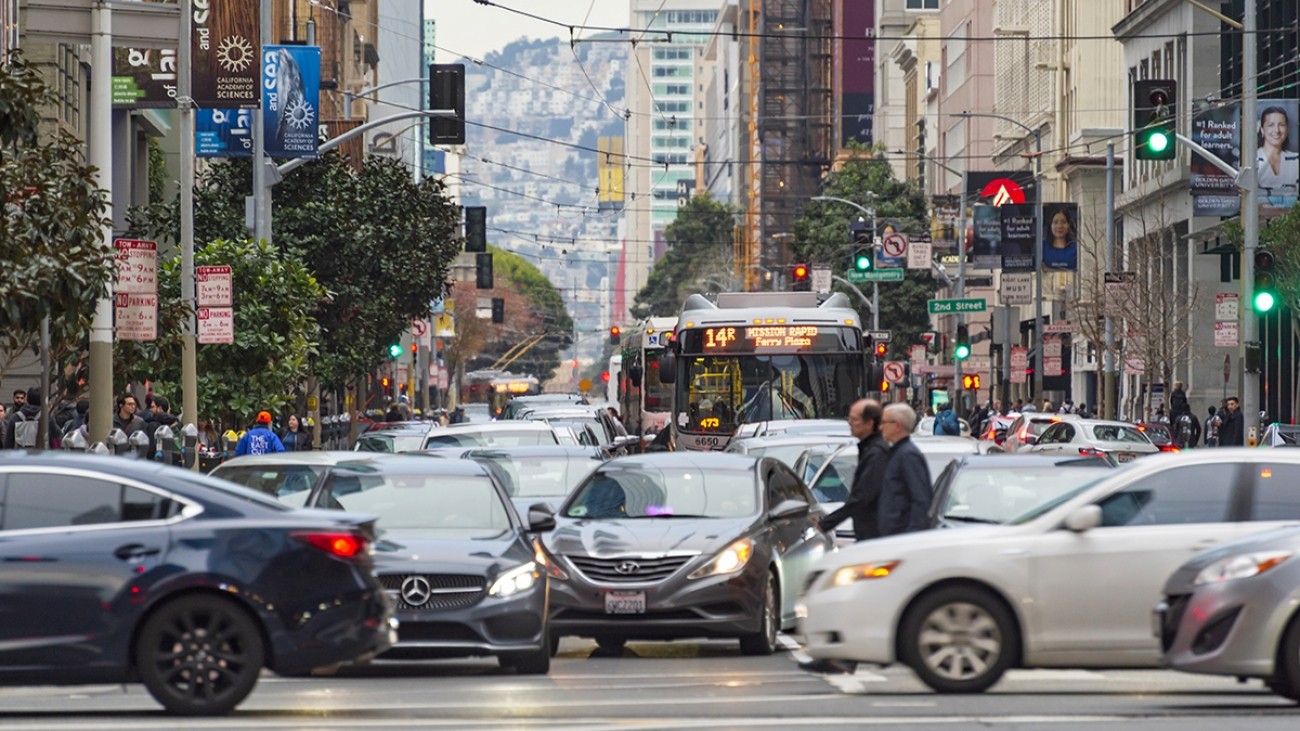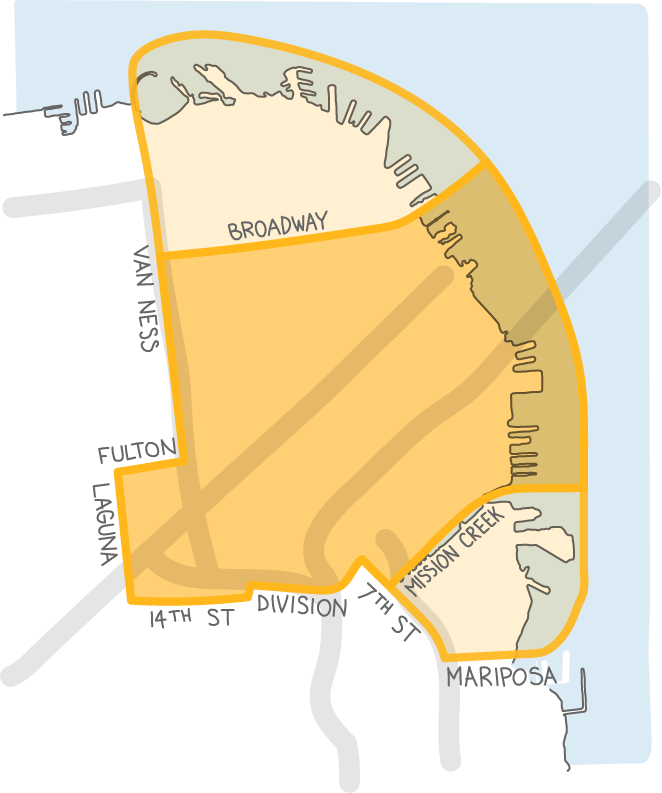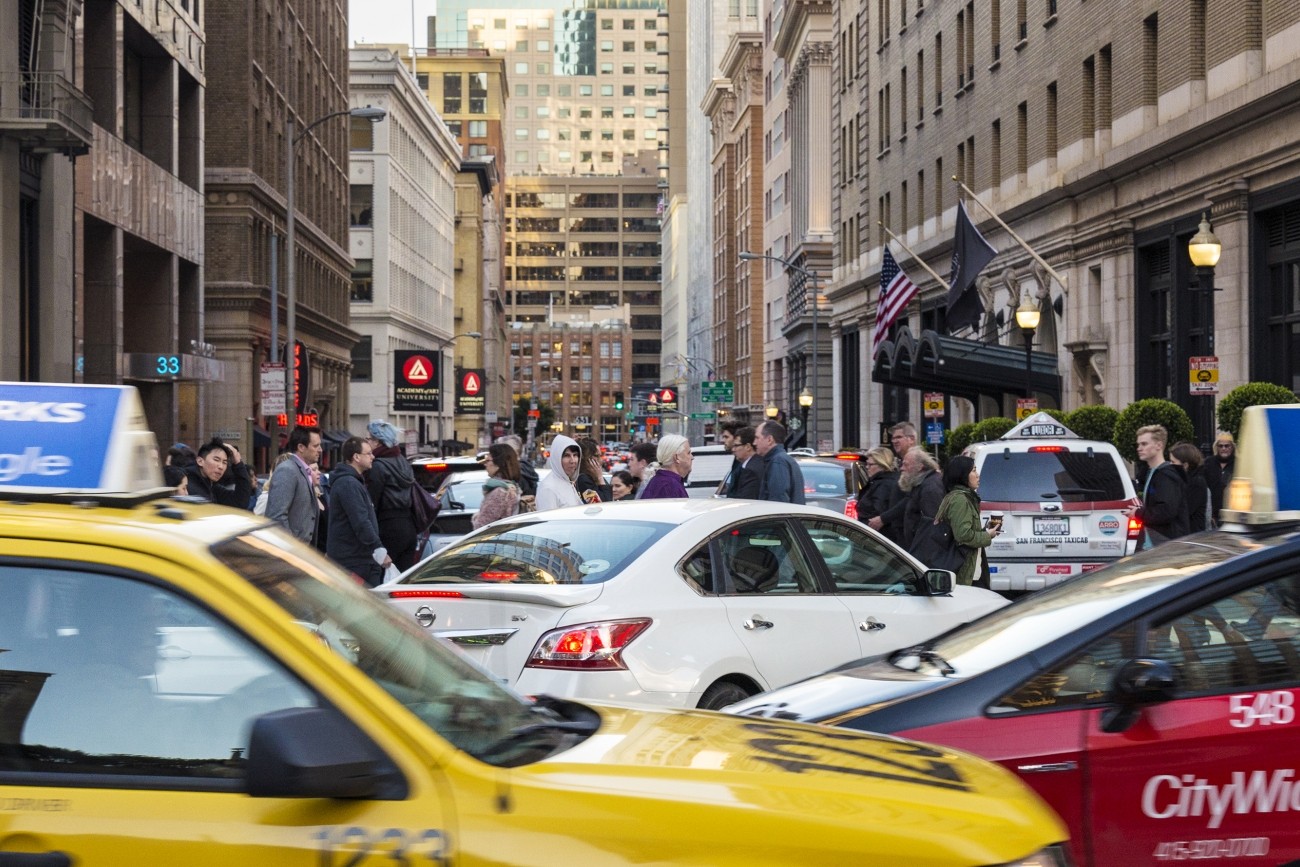
The Transportation Authority is exploring how a fee to drive downtown during busy hours — a strategy called congestion pricing — could get traffic moving and achieve goals around street safety, clean air, and equity when the economy recovers.
The Downtown Congestion Pricing study kicked off in 2019 and includes two major outreach rounds to gather feedback about how congestion pricing might work for San Francisco. Any proposed congestion pricing program would not be considered for implementation in the near-term. We are exploring congestion pricing as a possibility for when the economy rebounds in the future.
Where we are with the study
- After completing the first round of outreach in November 2020, our team identified three policy options for further study and updated the proposed zone map.
- We focused on engaging historically underinvested communities with guidance from a Policy Advisory Committee made of neighborhood, business, advocacy, and community representatives. The Policy Advisory Committee met on November 12, 2020 to provide input on the options for further study.
Outreach round 1 engagement tools
Workshops and meetings were conducted in-person (pre-pandemic) and virtually. Workshops, survey tools, posters, and some digital outreach were available in multiple languages, including Chinese, Spanish, and Filipino.
- 20+ workshops with 150+ participants from Communities of Concern
- 60+ meetings with community groups and the public
- 1000+ digital survey responses and 300 text survey responses
- Digital outreach via Website, Nextdoor, Facebook, Twitter, Instagram, WeChat, Linkedin
- 400+ posters in key corridors and downtown parking garages
- Newspaper advertisements
- Earned media in several news outlets
What we heard from outreach
- Input varied widely on whether congestion pricing is a good idea, from very opposed to strong enthusiasm.
- The most common concerns included affordability for people with low and moderate incomes, whether public transit service would be adequate given recent cuts due to COVID-19, what the recovery from the pandemic and recession will look like, and effects on businesses that are already struggling during the pandemic.
- The most popular potential benefits included transit improvements and health and quality of life improvements for congested neighborhoods.
- Income-based discounts and exemptions for the congestion pricing fee and discounts for public transit were a top priority.
- Of potential investments that could be included in the program, transit improvements were most popular, closely followed by pedestrian and bicycle safety upgrades.
Read the full synthesis from our first round of outreach (PDF)
Policy options for further study
Based on feedback we have heard so far, we developed three scenarios for further analysis and consideration.
- Scenarios 1 and 3 focus primarily on maximizing means-based exemptions, discounts, and transit subsidies while Scenario 2 balances means-based fees with resident- and toll-payer discounts.
- The table below outlines the discounts and resulting fee amounts that would be needed to achieve the study's 15% vehicle trip reduction goal.
| Scenario | 1 Inbound with means-based focus |
2 Inbound with means-based, resident, toll-payer discounts |
3 Two-way with means-based focus |
Scenario details |
|---|---|---|---|---|
| Fee direction | Inbound only | Inbound only | Two-way | An inbound only fee would be charged one-way only for entering the zone. A two-way fee would be charged for entering and exiting the zone. |
| Very Low Income 0 – 55% AMI Family of four: $65k |
100% discount ($0) | 100% discount ($0) | 100% discount ($0) | All scenarios would include a full exemption for very low-income drivers, plus different discount levels for low- and moderate-income drivers. |
| Low Income 55 – 80% AMI Family of four: $65 – 95k |
67% discount ($4.25) | 50% discount ($7.00) | 67% discount ($2.25) | |
| Moderate 80 – 120% AMI Family of four: $95 – 142k |
33% discount ($8.50) | 0% discount ($14.00) | 33% discount ($4.75) | |
| Middle & High 120% AMI Family of four: $142k+ |
0% discount ($12.50) | 0% discount ($14.00) | 0% discount ($7.00) | To achieve these discounts and meet the overall 15% vehicle trip reduction goal, the fees for the highest-income drivers would range from $7 for the two-way option up to $12-14 for the one-way only fee. |
| With Disability | 50% discount ($6.25) | 50% discount ($7.00) | 50% discount ($3.50) | All of the scenarios would include a 50% discount for people with disabilities whose incomes are too high to qualify for deeper income-based discounts and exemptions. |
| Bridge Toll Payer | 0% discount | $1.75 discount ($12.25) |
0% discount | Scenario 2 would include discounts for zone residents and bridge toll-payers who wouldn’t qualify for deeper income- or disability-based discounts. |
| Zone Resident | 0% discount | 50% discount ($7.00) | 0% discount | |
| Daily Cap | 2 round trips | 2 round trips | 2 round trips | Each scenario would include a daily fee cap at 2 round trips. |
| TNC | Fee charged per trip | Fee charged per trip | Fee charged per trip | In all scenarios every Uber/Lyft trip crossing the zone boundary or starting within the zone would be charged the same amount as the private vehicle fee. |
| Transit Subsidy | Yes | No | Yes | Scenarios 1 and 3 would include low-income transit fare subsidies such as increasing existing Lifeline and Clipper START discount levels. |
Zone map
The congestion pricing zone under consideration is in northeastern San Francisco, including the Downtown and SoMa neighborhoods. The map shows a proposed boundary, designed to include the most congested areas and freeway ramps while avoiding splitting neighborhoods wherever possible.
What’s next
- Our team is currently analyzing the three policy options to determine how well they meet our goals (PDF).
- We are preparing for our next round of outreach which is expected to begin in spring 2021. We will share the results of our analysis and seek your input to shape a final recommendation. Sign up to receive project updates to get notified when outreach begins.
- Join us during our next Policy Advisory Committee meeting on March 11 from 6:00 to 8:00 p.m.
Learn more and get involved
Visit the Study Webpage
Visit the Downtown Congestion Pricing Study webpage to learn more about the study and sign up to receive email updates.
Frequently Asked Questions
View Frequently Asked Questions.
Get a Virtual Presentation
Sign up to have our project team present to your community group.
View a Presentation
Download the November 12, 2020 presentation to the Policy Advisory Committee (PDF)
Download the December 8, 2020 presentation to the Transportation Authority Board (PDF)
Download the January 19, 2021 presentation to the SFMTA Board (PDF)
Contact Us
You can contact the project team at congestion-pricing@sfcta.org

